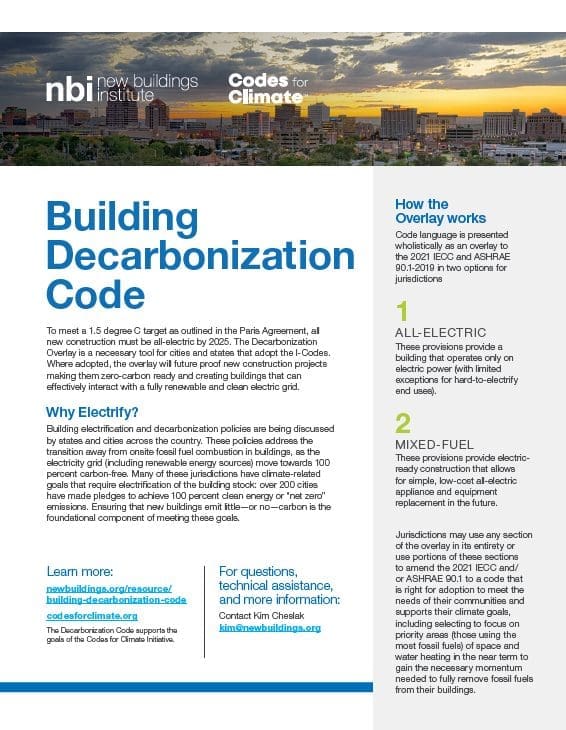Existing Building Decarbonization Code
Guideline / September 19, 2022 / Codes And Policy

The Existing Building Decarbonization Code is a new way for jurisdictions to reduce carbon emissions and meet Climate Action Plan and public health and equity goals. The need to address existing building stock is great, with 5.9 million existing commercial buildings in the U.S. comprising 97 billion square feet. New construction represents less than 2% of building activity in any given year, leaving a vast amount of outdated technologies in current building stock. NBI’s release of the Building Decarbonization Code provided the first off-the-shelf solution--as an overlay to the 2021 International Energy Conservation Code (IECC)--for jurisdictions to transform energy codes into decarbonization codes for new buildings. Expanding where that document left off, the Existing Building Decarbonization Code complements the original adding provisions specifically for existing buildings. The new model language covers both residential and commercial buildings including all-electric and mix-fuel energy use pathways.
Want to learn more? View our on demand webinar (10/12 live), Existing Building Decarbonization Code: the Gamechanger We Need Right Now in the Climate Fight, below:
Watch Now
Additional Resources
Building Decarbonization Code
The Building Decarbonization Code is a groundbreaking tool aiming to deliver carbon neutral performance. The Version 1.2 code language from NBI serves as a building decarbonization overlay to the 2021 International Energy Conservation Code (IECC) and is now compatible with ASHRAE 90.1. It is designed to help states and cities working to mitigate carbon resulting from energy use in the built environment, which accounts for 39% of U.S. emissions. It also offers market insight into rules that will determine how new buildings are designed and constructed in the future in order to curb the worst impacts of climate change.
Access the Building Decarbonization Code
Cost Study of the Building Decarbonization Code
This report analyzes the incremental first cost and life cycle cost of two common building types that follow the code language in NBI’s Building Decarbonization Code. The study, supported by the Natural Resources Defense Council (NRDC), analyzes first costs for both all-electric and mixed-fuel paths for single-family and medium office prototypes. It also includes life cycle cost analysis for the single-family scenario. Researchers used cost data from New York State, a relatively expensive market, in colder Climate Zone 5A.
Access the Cost Study of the Building Decarbonization Code
Residential and Commercial Decarbonization Factsheets
Also in the Code are solutions to inclusion of key electrification technologies like solar energy production, electric vehicles, battery storage, and demand response. These technologies are highlighted in new two factsheet pieces that illustrate how the multiple layers of decarbonization technology work together in both commercial and residential applications to achieve an all-electric building that works with the grid. As the building stock increases its reliance on the electric grid, buildings built with these grid integration technologies will be relied upon as grid assets, able to help shift, shape, and shave the peaks of the electric load.
Access the Residential Decarbonization Factsheet
Access the Commercial Decarbonization Factsheet



